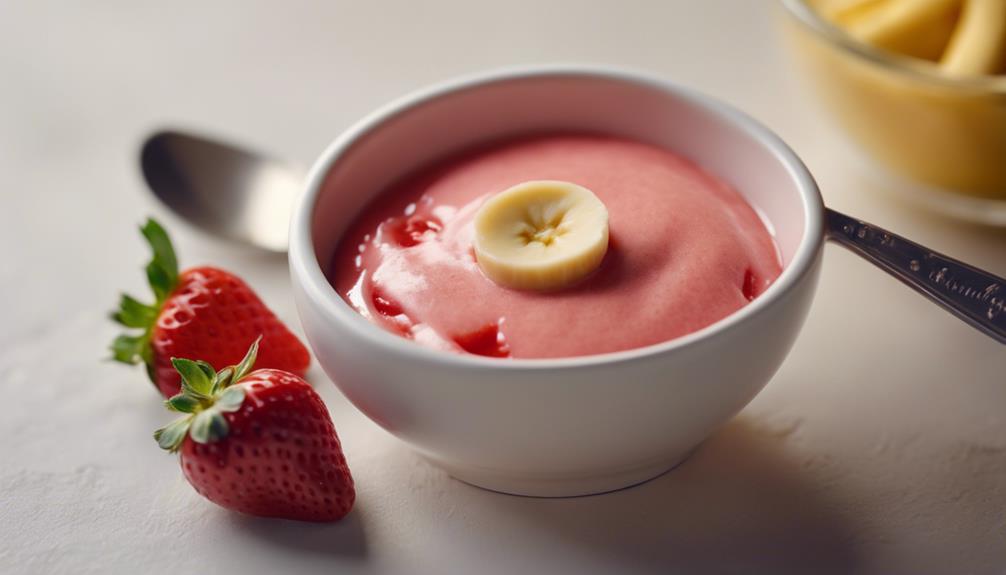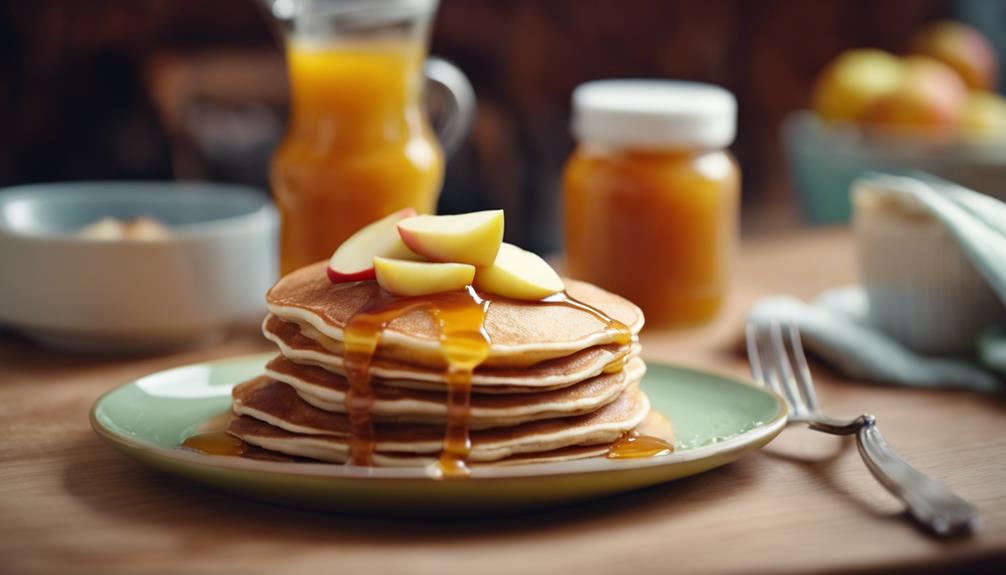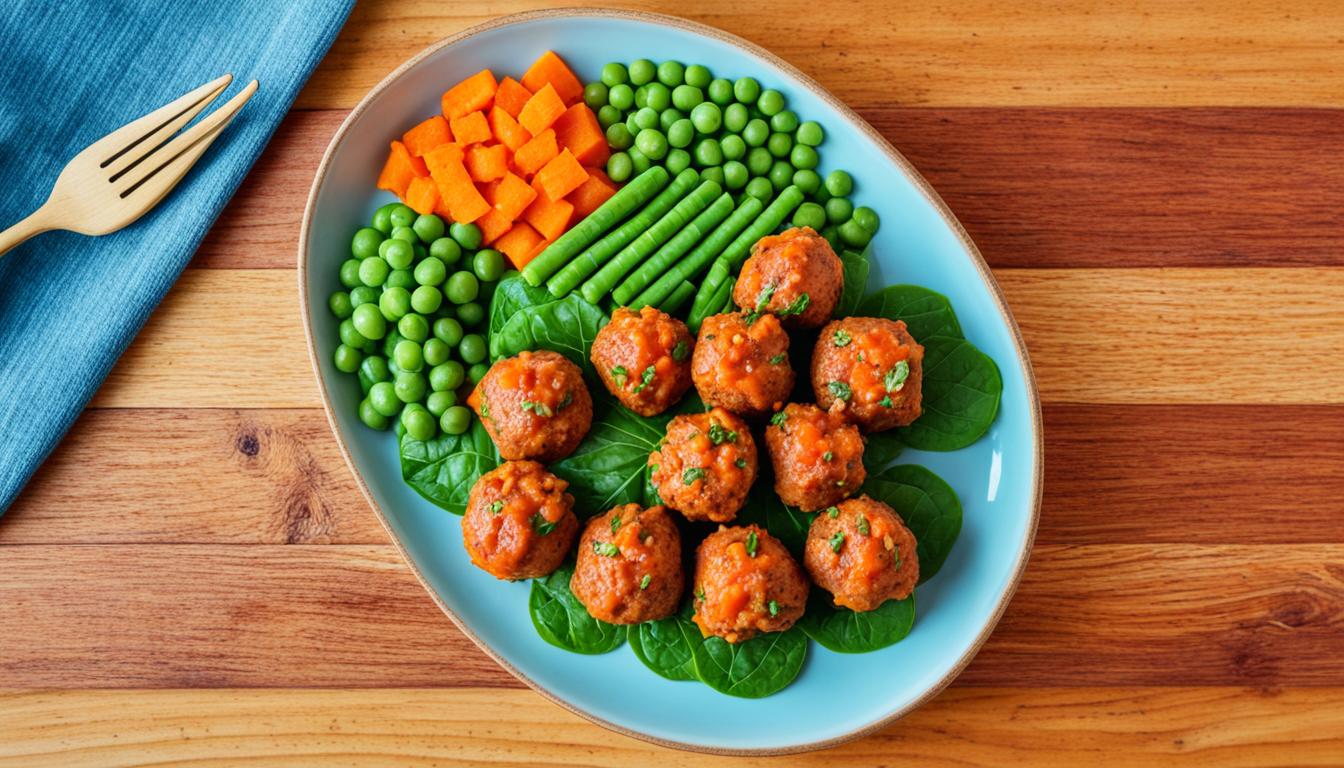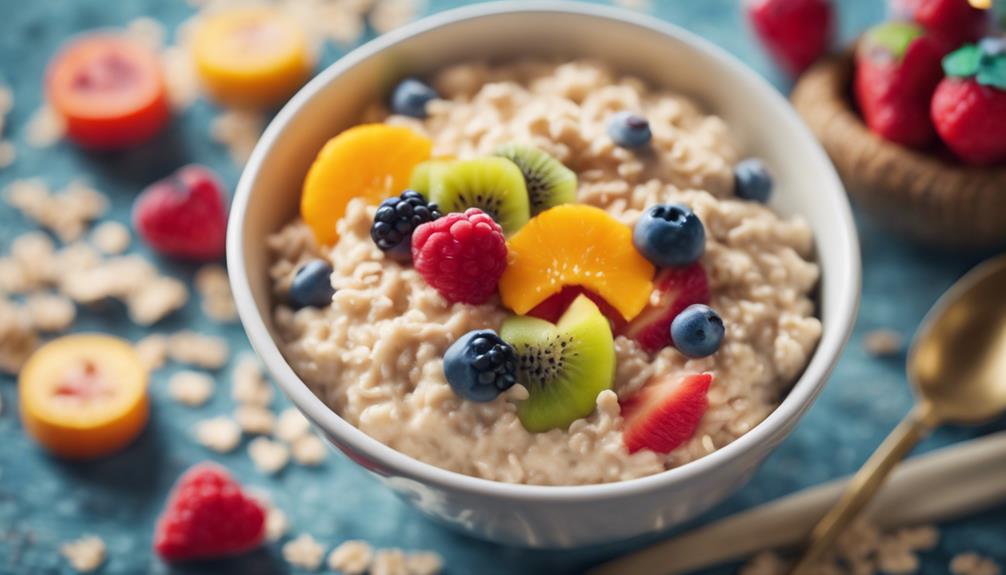Discover the irresistible blend of strawberry and banana baby food, a timeless favorite for babies. This classic combo offers a nutritious punch with Vitamin C, aiding iron absorption and providing fiber for digestion. Homemade strawberry puree is simple to make with ripe strawberries and a blender, offering a fresh option bursting with flavors. Mixing with other fruits like peaches or apples adds variety. Fresh strawberries maintain vibrant flavor, while cooking enhances some children's tolerance. Look into Beech-Nut Banana & Strawberries and Mighty 4® Flavor Combinations for convenient yet nutritious options. Explore further for more delightful combinations and nutritional benefits.
Key Takeaways
- Classic combo loved by babies for taste and nutrition.
- Provides essential vitamins, minerals, and fiber.
- Easy to prepare at home for freshness and control.
- Introduces diverse flavors to develop palate.
- Convenient store-bought options available for busy parents.
Benefits of Strawberry Puree
Discover the benefits of incorporating strawberry puree into your baby's diet for a nutritious start to their feeding journey. Strawberry puree is a fantastic source of Vitamin C, essential for your baby's growth and development. This vital vitamin aids in iron absorption, supporting your baby's overall health.
Additionally, strawberry puree contains fiber, which promotes digestion and helps maintain gut health in your little one. What makes strawberry puree even more appealing is its low sugar content compared to other fruits, making it a smart and healthy choice for your baby's diet.
Whether you opt for homemade strawberry puree that you can easily prepare at home or choose a convenient store-bought option, ensuring your baby gets a dose of this vitamin-packed fruit is a great way to introduce them to a variety of flavors and nutrients.
Homemade Strawberry Puree Recipe
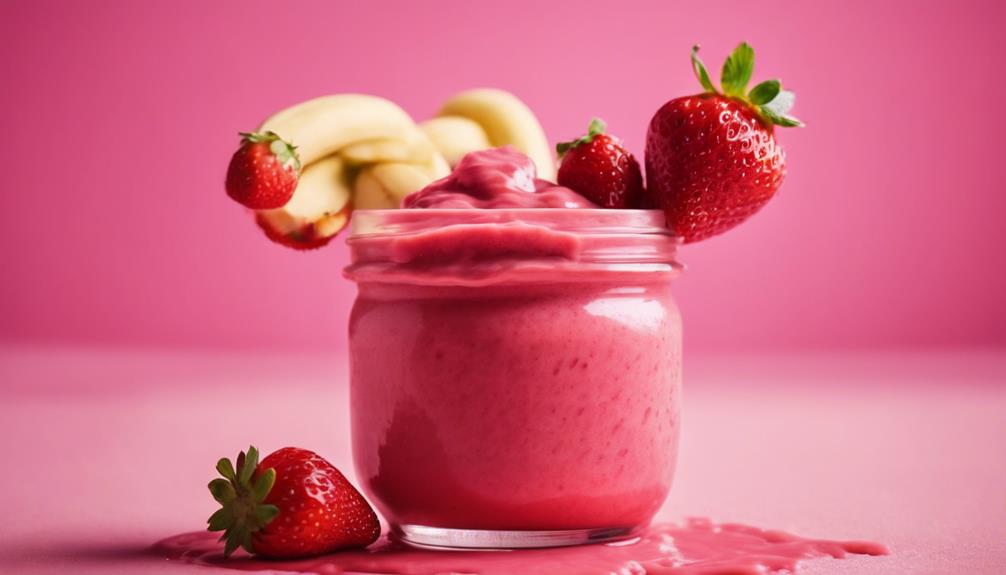
When making homemade strawberry puree for your baby, you'll need ripe strawberries, water or breast milk, and a blender.
Start by washing the strawberries, removing the stems, and blending them until smooth.
Store the puree in the fridge for up to 3 days or freeze it in ice cube trays for longer preservation, ensuring a convenient and nutritious option for your baby's meals.
Recipe Ingredients List
To make homemade strawberry puree for baby food, gather fresh ripe strawberries and a splash of water or lemon juice. The vibrant red color and natural sweetness of strawberries make them a perfect ingredient for your baby's first foods. Choosing organic strawberries can provide additional nutritional benefits, guaranteeing that your little one gets the best start in their food journey.
By pureeing strawberries at home, you can control the texture to suit your baby's preference and guarantee the freshness of the ingredients. Combining strawberries with bananas not only enhances the flavor but also balances the tartness of the strawberries with the sweetness of the bananas, creating a delightful taste that babies love.
Homemade baby food recipes offer a wide range of customization options and allow you to introduce various flavors and textures to your baby's diet, giving them a nutritious and delicious start to their culinary adventures.
Preparation Steps
For preparing the homemade strawberry puree, start by washing and hulling fresh ripe strawberries. Once the strawberries are prepped, place them in a blender with a splash of water or breast milk. Blend the mixture until it forms a smooth puree.
If the texture isn't entirely smooth, consider straining the puree to guarantee it's suitable for your baby's consumption. Homemade purees offer the advantage of controlling ingredients, steering clear of added sugars or preservatives commonly found in store-bought alternatives.
To enhance the flavor profile, experiment with adding other fruits like bananas or apples to the puree. After preparing the strawberry puree, store it in the refrigerator for up to 3 days or freeze it for future use.
This method provides a convenient and nutritious option for your baby, offering flexibility in meal planning and making sure they receive wholesome, homemade food.
Storage and Serving
Store the homemade strawberry puree in an airtight container in the fridge for up to 3 days to maintain its freshness and quality.
If you have extra puree that you won't be using right away, consider freezing it in ice cube trays for convenient portioning. When ready to use the frozen strawberry puree, thaw it in the fridge overnight or gently warm it using a microwave on low heat. This method helps preserve the nutrients and flavors of the strawberries for your baby's meals.
When serving the homemade strawberry puree, you have the flexibility to offer it alone as a tasty treat or mix it with other fruits, vegetables, or baby cereal for added variety and nutrition. Experiment with different combinations to see what your baby enjoys the most.
Providing homemade strawberry puree gives your little one a fresh and wholesome option that can contribute to their balanced diet.
Strawberry Puree Combination Ideas
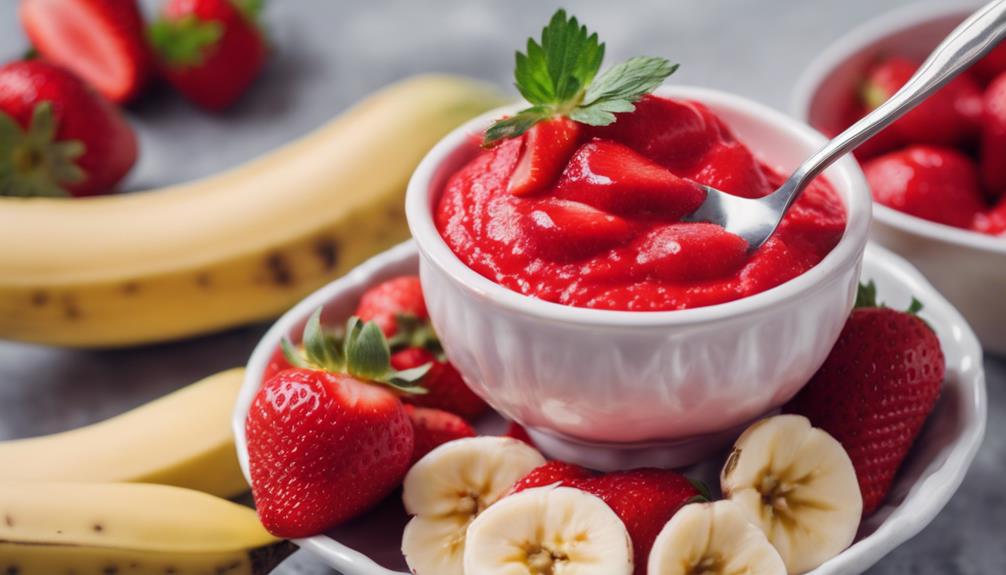
Consider mixing strawberry puree with various fruits to create delicious and nutritious combinations for your little one. Strawberries for baby, particularly in stage 2 baby food, can be paired with a variety of fruits to introduce different flavors and nutrients to your growing infant.
Try blending strawberry puree with peach for a tasty and nutritious option. Apple and strawberry puree offer a mix of sweet and tangy flavors that babies enjoy. For a tropical twist, combine strawberry puree with mango to introduce new and exciting tastes.
Another creamy and nutrient-rich combination is banana, strawberry, and avocado puree, perfect for providing essential nutrients for your little one. If you're looking for a well-rounded taste experience, consider mixing strawberry with carrot and pear puree to combine sweet, earthy, and tart flavors.
These combinations not only offer a diverse range of tastes but also provide essential vitamins and minerals for your baby's growth and development.
Fresh Vs. Frozen Strawberries
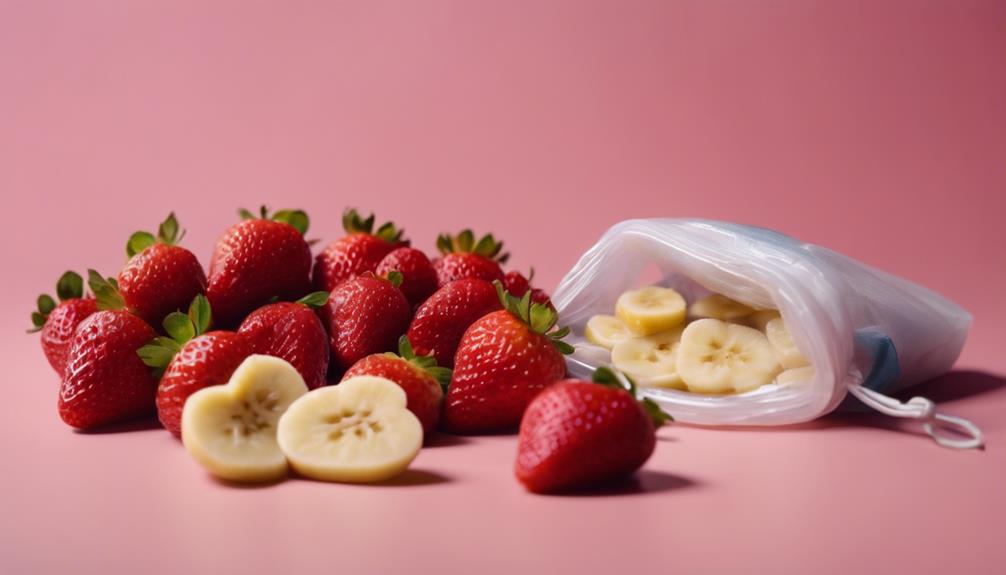
When deciding between fresh and frozen strawberries for baby food, consider factors like nutrient content, texture after thawing, and potential pesticide exposure.
Fresh strawberries generally retain more nutrients, while thawing frozen strawberries can lead to a softer texture for pureeing.
Ultimately, your choice will impact the flavor, texture, and overall quality of the strawberry banana baby food you prepare.
Freshness Vs. Frozen
Choosing fresh strawberries over frozen ones guarantees maximum retention of nutrients in your homemade strawberry banana baby food. Fresh strawberries are known to preserve more nutrients compared to their frozen counterparts.
However, if fresh organic strawberries aren't readily available, using thawed frozen strawberries can be a suitable alternative. It's essential to opt for organic strawberries to guarantee safety and nutrition for your baby.
When preparing your baby food, be mindful of the cooking method as high heat can diminish the nutrient content in strawberries. Surprisingly, cooking strawberries may also help reduce allergic reactions in some children, making it a beneficial option for babies with sensitivities.
Nutrient Retention Methods
To maintain peak nutrient retention in your homemade strawberry banana baby food, it's crucial to understand how different cooking methods impact the nutrients in fresh versus frozen strawberries.
Fresh strawberries generally preserve more nutrients compared to their frozen counterparts. When preparing baby food, opt for lightly cooking the strawberries instead of using high heat methods that can reduce their nutrient content.
Organic strawberries may provide higher nutritional benefits for your little one due to the absence of pesticides and chemicals. When cooking strawberries, steaming is a superior method for preserving nutrients than simmering.
Flavor and Texture
Fresh strawberries offer a more vibrant flavor and texture compared to frozen strawberries in baby food purees. The natural sweetness and juiciness of fresh strawberries can enhance the overall taste of the puree, providing a more intense fruity flavor. Additionally, the texture of fresh strawberries in purees tends to be smoother and more pleasant for babies, as they blend easily into a creamy consistency. On the other hand, frozen strawberries, while a convenient option, may not deliver the same level of freshness and vibrancy in flavor. The freezing process can sometimes alter the texture of the strawberries, resulting in a slightly softer or mushier feel in the puree.
| Aspect | Fresh Strawberries | Frozen Strawberries |
|---|---|---|
| Flavor | Vibrant and intense | Slightly subdued |
| Texture | Smooth and pleasant | Softer or mushier |
| Nutrients | Higher nutrient content due to minimal processing | Similar nutritional benefits to fresh strawberries |
Nutritional Comparison: Cooked Vs. Raw
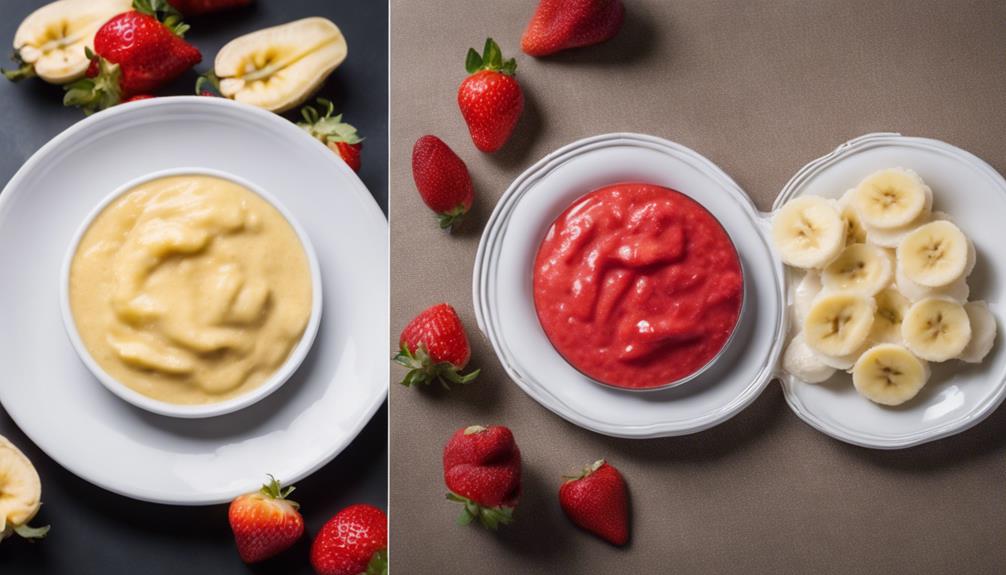
When comparing the nutritional content of cooked versus raw strawberry puree for baby food, it's essential to take into account how different preparation methods impact the retention of key nutrients.
Here are three important points to keep in mind:
- Nutrient Retention: Raw strawberry puree retains more nutrients, including Vitamin C and antioxidants, compared to cooked strawberry puree. Cooking strawberries can reduce their nutritional value by breaking down heat-sensitive nutrients.
- Cooking Methods: Lightly cooking strawberries, such as steaming, can help preserve more nutrients than simmering or boiling. This method retains more of the essential vitamins and minerals needed for your baby's growth and development.
- Allergic Reactions: Some children may have reduced allergic reactions to strawberries when they're cooked rather than raw. Introducing both raw and lightly cooked versions of strawberry puree can be beneficial in ensuring your baby receives a variety of nutrients while minimizing potential allergic responses.
Storing and Serving Strawberry Puree
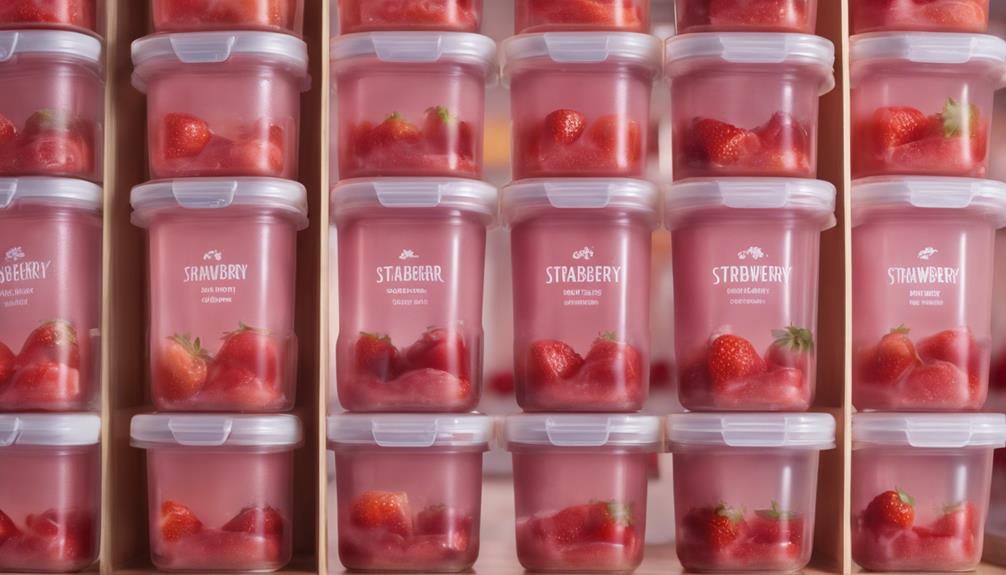
After preparing your strawberry puree, make sure you store it in the fridge for up to 3 days to maintain its freshness. It's essential to keep the puree refrigerated to prevent spoilage and guarantee your baby's safety.
If you have frozen strawberry puree, thaw it in the fridge overnight or use the defrost setting on a microwave for a quick thaw. Refrain from refreezing any leftover puree as it may impact the taste and texture.
When serving the strawberry puree to your baby, consider warming it slightly or serving it at room temperature for their comfort. Mixing the strawberry puree with other fruits or vegetables can introduce new and exciting flavors to your baby's palate, helping them develop a taste for different foods early on.
Experimenting with various combinations can provide a well-rounded diet for your little one while keeping mealtime enjoyable and nutritious.
Additional Baby Food Puree Recipes
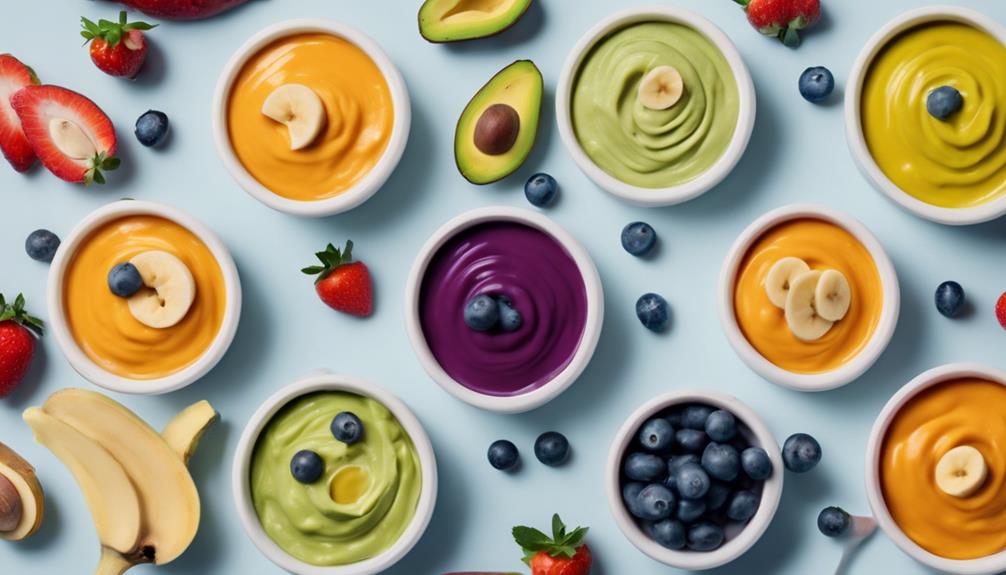
Try combining strawberry puree with various fruits, vegetables, and proteins to create diverse and nutritious baby food options that cater to your little one's developing taste buds and nutritional needs. Here are some ideas to help you introduce new flavors and textures into your baby's diet:
- Fruit Combinations:
Mix strawberry puree with fruits like peach, apple, mango, banana, avocado, carrot, or pear to provide a variety of tastes and nutrients for your baby. These combinations can offer a sweet and tangy experience while ensuring a well-rounded meal.
- Vegetable Pairings:
Experiment with adding vegetables such as kale or sweet potatoes to your strawberry puree. This can introduce different textures and flavors, creating a balanced and wholesome meal for your little one.
- Protein and Grain Additions:
Enhance the nutritional value of your baby's food by incorporating protein sources like Greek yogurt or beans into the strawberry puree. Additionally, consider adding grains like millet or oats to provide extra fiber and energy, supporting your growing baby's needs.
Beech-Nut Banana & Strawberries Details
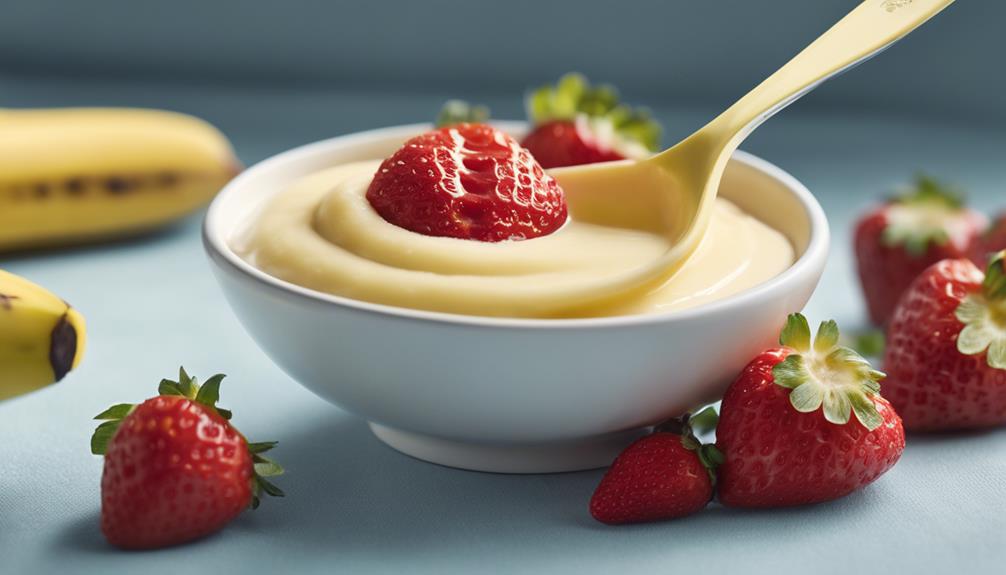
Explore the details of Beech-Nut Banana & Strawberries Jar, a Stage 2 baby food highlighting a blend of creamy bananas and ripe strawberries.
This 4 oz jar of non-GMO Project verified baby food is tailored for infants around 6 months old.
The ingredients are simple and wholesome, including bananas, strawberries, water, and lemon juice concentrate. Importantly, there are no artificial additives or added sugars in this product, ensuring a pure fruit experience for your little one.
The jar is vacuum-sealed to maintain freshness, and once opened, it should be refrigerated and consumed within 3 days.
Beech-Nut Banana & Strawberries Jar offers a convenient and nutritious option for introducing classic fruit flavors to your baby's diet.
With its focus on natural ingredients and the assurance of non-GMO certification, this baby food provides a reliable choice for parents seeking quality nutrition for their little bundle of joy.
Mighty 4® Flavor Combinations
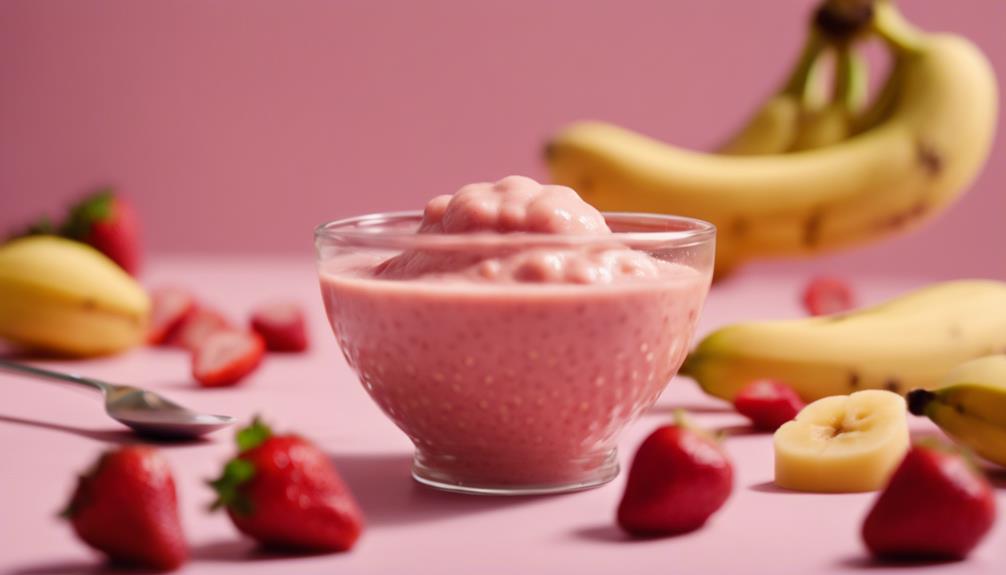
Mighty 4® offers a variety of flavorful fruit pairings that create nutrient-rich blends perfect for your little one's taste buds. These combinations feature organic fruits, veggies, protein, and grains to deliver a well-rounded flavor experience filled with vital nutrients.
The Plum Standard guarantees that Mighty 4® upholds top-notch ingredients, non-GMO products, and a commitment to food safety, establishing it as a dependable option for encouraging palate development in young children.
Flavorful Fruit Pairings
Plum Organics emphasizes flavorful fruit pairings like banana, blueberry, sweet potato, carrot, Greek yogurt, and millet in their Mighty 4® line of baby food products.
When exploring the world of baby food, consider these enticing combinations:
- Banana and Blueberry: A delightful duo that combines the sweetness of ripe bananas with the tartness of blueberries, providing a burst of flavor and essential nutrients for your little one.
- Sweet Potato and Carrot: Rich in vitamins and minerals, this pairing offers a blend of earthy sweetness from sweet potatoes and the vibrant orange hue of carrots, promoting healthy growth and development.
- Greek Yogurt and Millet: Adding a creamy texture and probiotic benefits, Greek yogurt complements the nutty flavor and nutritional value of millet, creating a well-rounded meal option for your baby.
These organic choices not only introduce diverse tastes but also guarantee that your baby enjoys a nutritious and balanced diet from the start.
Nutrient-Rich Blends
When looking for nutrient-rich blends in baby food options, consider the flavorful combinations offered by Mighty 4® that cater to your baby's growth and development needs.
Mighty 4® baby food provides a balanced diet with organic fruits, veggies, protein, and grains, ensuring your baby receives essential nutrients for healthy development.
The flavor combinations in Mighty 4® baby food are specifically designed to fuel your baby's growth, encouraging palate expansion by introducing a variety of flavors and textures.
These nutrient-rich blends not only offer a thicker texture but also provide a flavor explosion that engages your baby's taste buds, making mealtime enjoyable and exciting.
Gerber Apple Strawberry Banana Details
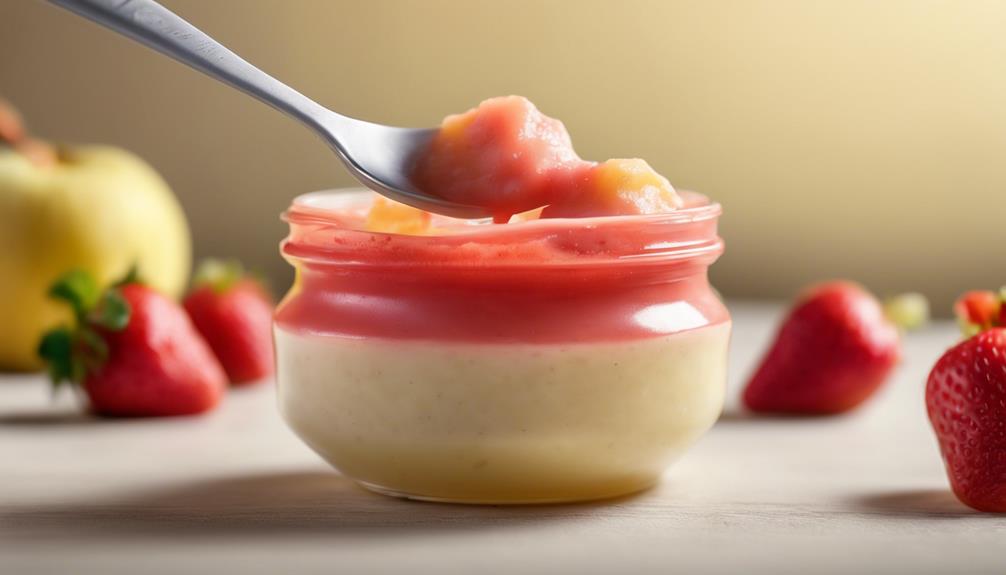
Exploring the details of Gerber Apple Strawberry Banana baby food reveals key information essential for understanding its ingredients and usage.
Gerber Apple Strawberry Banana baby food is designed for babies progressing to more textured foods, making it part of the 2nd Foods stage, providing a blend of organic strawberries, apples, bananas, vitamin C, and lemon juice concentrate.
Each package includes two 4 oz tubs, manufactured in the US to maintain quality and safety standards are met, and should be refrigerated after opening for consumption within 2 days.
The packaging of Gerber Apple Strawberry Banana baby food lacks specific details such as age recommendations, serving suggestions, preparation instructions, storage guidelines, or dietary considerations, requiring caregivers to rely on general feeding knowledge.
Understanding these details allows for a more informed choice when selecting this product for your little one.
Frequently Asked Questions
What to Mix Strawberries With for Baby Food?
When making baby food, mix strawberries with apples, mangoes, peaches, avocados, or carrots and pears. These combinations offer a variety of flavors and textures that babies love, providing a tasty and nutritious experience for their developing palates.
Can I Give My 4 Month Old Blended Strawberries?
You shouldn't give your 4-month-old blended strawberries. They're a choking hazard and may upset their tummy. Wait till around 6 months and start with safer options like banana or sweet potato. Always consult your pediatrician first.
When Should a Baby Stop Taking Purées?
You should consider moving your baby from purees to mashed or soft solid foods around 8-10 months. Signs of readiness include improved tongue control and chewing ability. Gradually introduce chunkier textures to help them adapt.
Can I Give My 4 Month Old Blended Banana?
You should wait until your baby is at least 6 months old before offering blended foods like banana. Starting solids too early can lead to allergies and digestive issues. Always consult with your pediatrician for guidance on introducing new foods.
Conclusion
To wrap up, although the classic blend of strawberry banana baby food may appear to be a perfect match, the nutritional advantages may not be as clear-cut.
Due to differing amounts of vitamins, minerals, and antioxidants in fresh versus frozen strawberries, it's crucial to thoughtfully weigh the most suitable choice for your little one.
Keep in mind, not all baby food choices are identical, so select wisely for maximum nutrition for your developing baby.
